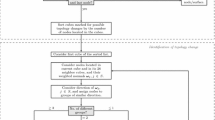Abstract
Level-Set methods have been successfully applied to 2D and 3D boundary detection problems. The geodesic active contour model has been particularly successful. Several algorithms for the discretisation have been proposed and the banded approach has been used to improve efficiency, which is crucial in 3D boundary detection. In this paper we propose a new scheme to numerically represent and evolve surfaces in 3D. With the new scheme, efficiency and accuracy are further improved. For the representation, space is partitioned into tetrahedra and finite elements are used to define the level-set function. Extreme sparsity is obtained by maintaining data only for tetrahedra that contain the zero level-set. We formulate the evolution PDE in weak form and incorporate a normalisation term. We obtain a stable scheme with consistent sub-grid accuracy without having to rely on any re-initialisation procedure. Boundary detection is performed using an anisotropic extension of the isotropic geodesic model. With the sparse representation, the anisotropic model is computationally feasible. We present experimental results on volumetric data sets including images with a significant amount of noise.
This work was supported by the EPSRC, the Cambridge European Trust and DAAD.
Preview
Unable to display preview. Download preview PDF.
Similar content being viewed by others
References
Malladi, R., Sethian, J., Vemuri, B.: Shape modeling with front propagation: A level set approach. IEEE Trans. Pattern Analysis and Machine Intelligence 17, 158–175 (1995)
Kichenassamy, S., Kumar, A., Olver, P., Tannenbaum, A., Yezzi, A.: Gradient flows and geometric active contour models. In: Proc. IEEE Int. Conf. on Computer Vision, pp. 810–815 (1995)
Yezzi, A., Kichenassamy, S., Kumar, A., Olver, P., Tannenbaum, A.: A geometric snake model for segmentation of medical imagery. IEEE Trans. Med. Imaging 16, 199–209 (1997)
Caselles, V., Kimmel, R., Sapiro, G., Sbert, C.: Minimal surfaces: A geometric three dimensional segmentation approach. Numerische Mathematik 77, 423–425 (1997)
Boykov, Y., Kolmogorov, V.: Computing geodesics and minimal surfaces via graph cuts. In: Proc. IEEE Int. Conf. on Computer Vision, pp. 26–33 (2003)
Terzopoulos, D., Metaxas, D.: Dynamic 3D models with local and global deformations: Deformable superquadrics. IEEE Trans. Pattern Analysis and Machine Intelligence 13, 703–714 (1991)
Osher, S., Sethian, J.: Fronts propagating with curvature-dependent speed: Algorithms based on Hamilton-Jacobi formulations. J. of Comp. Phys. 79, 12–49 (1988)
Sethian, J.: Level Set Methods. Cambridge University Press, Cambridge (1999)
Sapiro, G.: Geometric Partial Differential Equations and Image Processing. Cambridge University Press, Cambridge (2001)
Osher, S., Paragios, N.: Geometric Level Set Methods in Imaging Vision and Graphics. Springer, New York (2003)
Preußer, T., Rumpf, M.: A level set method for anisotropic geometric diffusion in 3D image processing. SIAM J. on Applied Math. 62(5), 1772–1793 (2002)
Gomes, J., Faugeras, O.: Reconciling distance functions and level sets. Journal of Visual Communication and Image Representation 11, 209–223 (2000)
Weber, M., Blake, A., Cipolla, R.: Sparse finite elements for geodesic contours with level-sets. In: Proc. European Conf. on Computer Vision, Prague, Czech Republic, pp. 391–404. Springer, Heidelberg (2004)
Goldenberg, R., Kimmel, R., Rivlin, E., Rudzsky, M.: Fast geodesic active contours. IEEE Trans. Image Processing 10, 1467–1475 (2001)
Weickert, J., ter Haar Romeny, B., Viergever, M.: Efficient and reliable schemes for nonlinear diffusion filtering. IEEE Trans. Image Processing 7, 398–410 (1998)
Weber, M.: Curve and Surface Reconstruction from Images and Sparse Finite Element Level-Sets. PhD thesis, Department of Engineering, University of Cambridge (2004)
Do Carmo, M.: Differential Geometry of Curves and Surfaces. Prentice-Hall, Englewood Cliffs (1976)
Kimmel, R., Bruckstein, A.: Regularized Laplacian zero crossings as optimal edge integrators. International Journal of Computer Vision 53, 225–243 (2003)
Vasilevskiy, A., Siddiqi, K.: Flux maximizing geometric flows. In: Proc. IEEE Int. Conf. on Computer Vision, Vancover, Canada, pp. 149–154 (2001)
Edelsbrunner, H.: Geometry and Topology for Mesh Generation. Cambridge University Press, Cambridge (2001)
Zienkiewicz, O., Morgan, K.: Finite Elements & Approximation. John Wiley & Sons, New York (1983)
Schwarz, H.: Numerische Mathematik. Teubner, Stuttgart (1993)
Author information
Authors and Affiliations
Editor information
Editors and Affiliations
Rights and permissions
Copyright information
© 2005 Springer-Verlag Berlin Heidelberg
About this paper
Cite this paper
Weber, M., Blake, A., Cipolla, R. (2005). Sparse Finite Element Level-Sets for Anisotropic Boundary Detection in 3D Images. In: Kimmel, R., Sochen, N.A., Weickert, J. (eds) Scale Space and PDE Methods in Computer Vision. Scale-Space 2005. Lecture Notes in Computer Science, vol 3459. Springer, Berlin, Heidelberg. https://doi.org/10.1007/11408031_47
Download citation
DOI: https://doi.org/10.1007/11408031_47
Publisher Name: Springer, Berlin, Heidelberg
Print ISBN: 978-3-540-25547-5
Online ISBN: 978-3-540-32012-8
eBook Packages: Computer ScienceComputer Science (R0)




